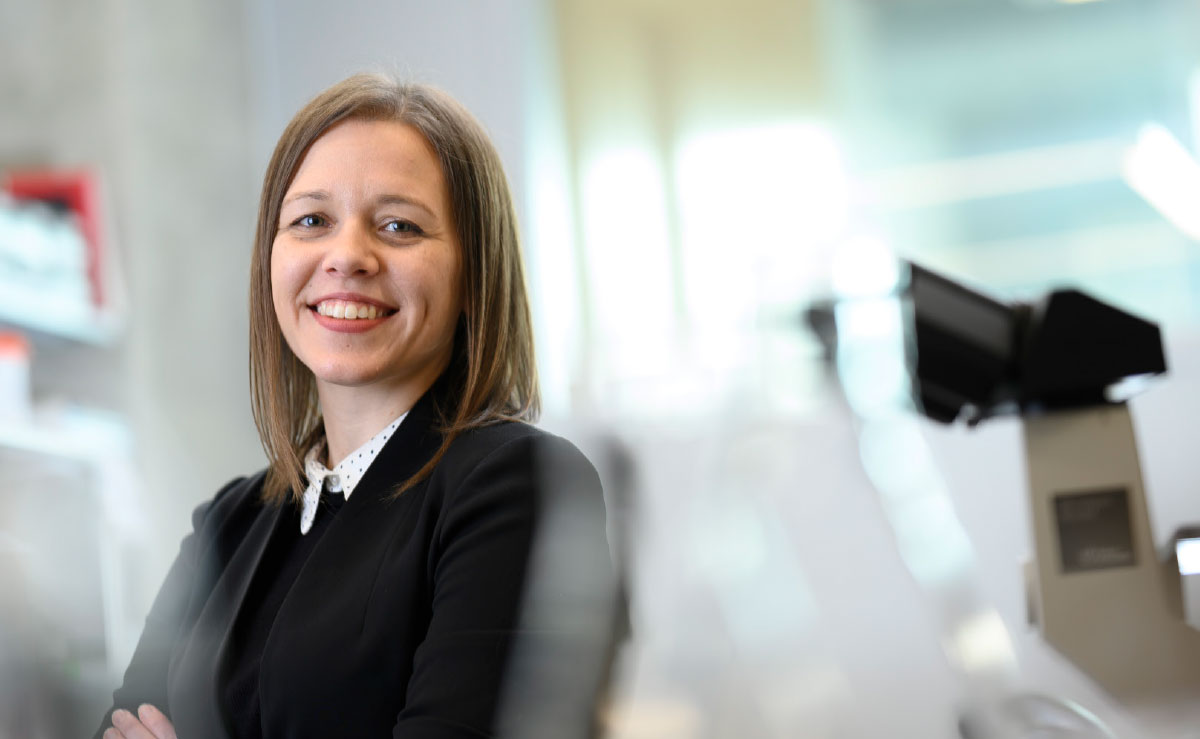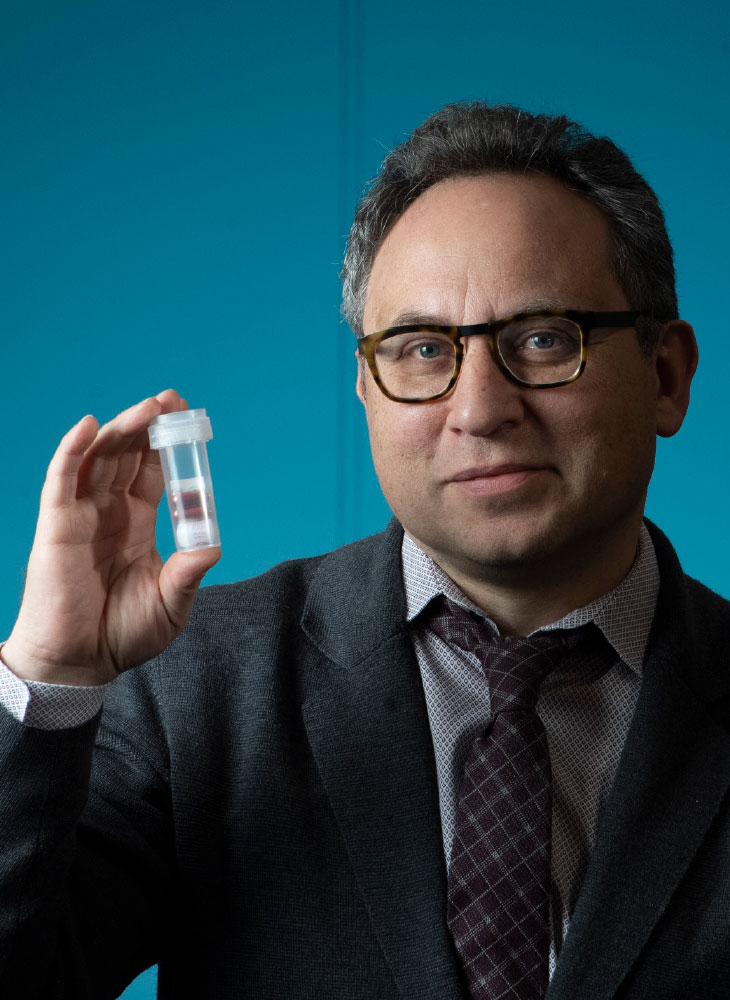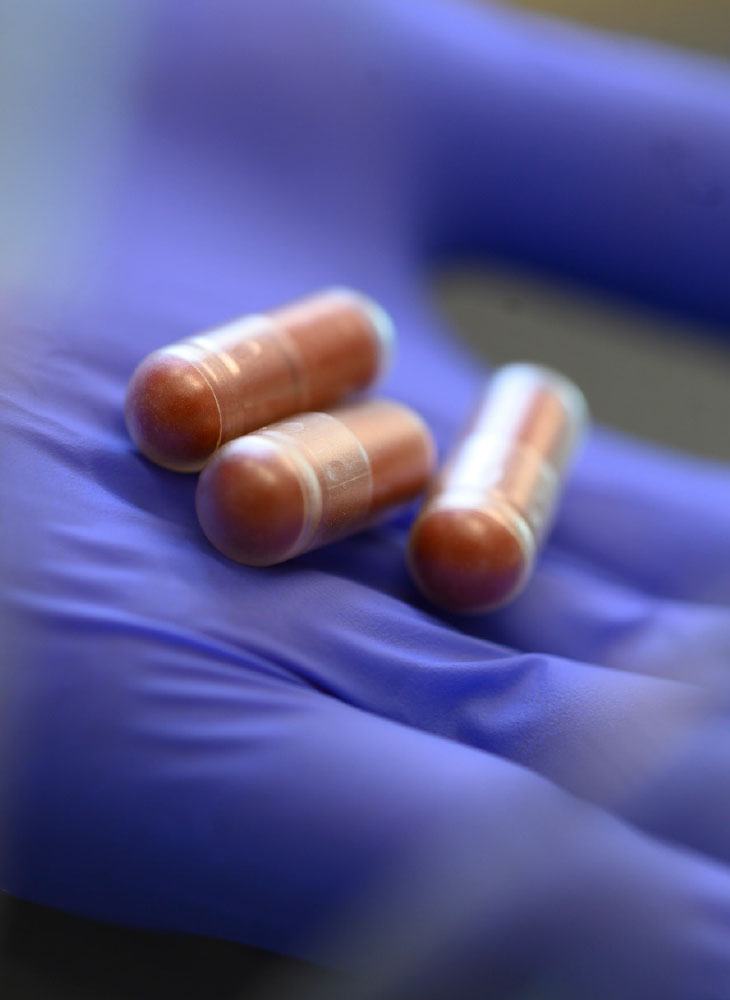
Dr. Alex Khoruts shares the important role the microbiome plays in a patients recovery. As the director of the U’s Microbiota Therapeutics Program he talks about his hopes that a multidisciplinary center that facilitates all microbiome research will soon be a possibility at the UMN.
GUT FEELING
Patient-turned-researcher teams up with her doctor to advance U of M's pioneering microbiota transplant program
By Justin Harris
UMN Medical School Medical Bulletin
May 12, 2020
For more than a year, an unwelcome guest waylaid Amanda Kabage’s life. Debilitating gastrointestinal symptoms — abdominal pain, blood in her stool, and trips to the bathroom — occurred so frequently that leaving the house became nearly impossible for the then-32-year-old. The culprit: recurring Clostridium difficile, or C. diff, a bacterial infection of the gut.
C. diff is a common complication of antibiotic exposure. Ironically, the standard treatment for the infection is also antibiotics. Often the treatment works, but about 20% of the time, it fails. In those cases, each round of treatment makes the C. diff infection more difficult to eradicate. Every year in the United States, about 100,000 people become trapped in a cycle of recurrent C. diff infections. Kabage was one of them.
She read online about a new treatment that was showing promise for patients like her: an intestinal microbiota transplant. The intervention involves taking gut bacteria from a healthy person and putting it into the intestinal tract of someone who’s sick.
At the time, only a few physicians in the U.S. had Food and Drug Administration approval to do microbiota transplants. As luck would have it, one of them — gastroenterologist Alexander Khoruts, M.D. — worked at the same place Kabage did: the University of Minnesota.
Khoruts, the medical director of the U’s Microbiota Therapeutics Program and a professor in the Medical School’s Division of Gastroenterology, Hepatology, and Nutrition, met with Kabage and agreed a transplant could work. Khoruts scheduled the procedure, and after months of misery, Kabage finally had reason to be hopeful.
Just a few hours after her transplant, Kabage felt an unfamiliar energy bubbling up in her stomach, growls rumbling to a crescendo loud enough that her friend across the room could hear it. Kabage knew right away that the sound was the transplanted gut microbes settling in their new home.
“There’s just this physical and instinctual feeling that something different is happening,” she recalls. “The new microbes are here, and they’re going to work.”
Kabage was right — the transplant worked. Her chronic diarrhea stopped almost immediately, she started eating solid food again, and she returned to working out at the gym, running, and playing racquetball.
“My life had come to a screeching halt,” Kabage says. “And then it all came back, my completely normal life, within just a few weeks.”
 Amanda Kabage battled a debilitating C. diff infection for more than a year. Today she’s a research coordinator working with the team that cured her. (Photo: Scott Streble)
Amanda Kabage battled a debilitating C. diff infection for more than a year. Today she’s a research coordinator working with the team that cured her. (Photo: Scott Streble)
UNDERSTANDING THE MICROBIOME
By the time he met Kabage in 2013, Khoruts was nearly five years into his exploration of the microbiome — the collective term for the trillions of bacteria, fungi, and viruses that live within each person, mostly in the large intestine.
Scientists knew that these microscopic creatures help perform important tasks in the body, including food digestion, immune system regulation, and nutrient production. But the mechanics of how they worked remained a mystery.
Khoruts learned that the microbiome functions much like a city, with different, coexisting individuals working together as communities. When these communities are diverse and their interactions are plentiful, the microbes’ human host tends to be healthier. And when they’re not, the person usually suffers.
Khoruts began to focus his research on the gut microbiome in 2008, after performing his first microbiota transplant. As in Kabage’s case, C. diff had derailed the 61-year-old patient’s entire life. Working with Michael Sadowsky, Ph.D., a microbial ecologist at the U, Khoruts found an alarming lack of normal microbes in the woman’s intestine. He asked the patient’s husband for a stool donation, which was used to create a microbiota transplant and administered by way of a colonoscopy.
“She reported feeling better while still in the recovery suite. Soon, we found that her husband’s bacteria had taken over,” Khoruts says. The demonstration of microbial transplant was groundbreaking, proving for the first time that a donor’s microbes could survive and thrive in the recipient’s gut. “It was at that point that I realized this could help a lot of people.”
Soon after, the Microbiota Therapeutics Program was born, and Khoruts got to work refining his transplant capabilities. He created the world’s first microbiota donor program, which recruits healthy individuals to donate stool samples that can be turned into microbiota transplants — the same kind Kabage and more than 700 other C. diff patients have received at the U since 2008. The methods published by Khoruts and Sadowsky after the first transplant were adopted by groups around the world and have since helped to treat nearly 100,000 patients suffering with C. diff.
As the Microbiota Therapeutics Program continued to grow, Khoruts realized the donor initiative needed the attention of a full-time research coordinator. He wanted someone who had detailed knowledge of the microbiota transplant process and who had experience navigating the complicated rules and regulations of health-related research.
Kabage — who was working at the U as a research coordinator in pediatric health at the time of her C. diff diagnosis — was a serendipitously perfect choice.
“Alex thought, ‘What are the chances that one of my patients is a researcher at the University who’s become very passionate about this therapy?’” Kabage says.
FROM COLONOSCOPY TO CAPSULES

 Alexander Khoruts, M.D., and colleagues can now deliver a microbiota transplant via capsules rather than by way of colonoscopy. (Photos: Scott Streble)
Alexander Khoruts, M.D., and colleagues can now deliver a microbiota transplant via capsules rather than by way of colonoscopy. (Photos: Scott Streble)
Since taking over about six years ago, Kabage says the donor program has become a “well-oiled machine.”
Interested donors undergo an extensive health history questionnaire and repeated in-person exams that include testing of blood and stool for infections and other measures of health. Common disqualifiers include food allergies, a history of asthma, and use of prescription medications.
“They’re literally the heathiest people we can find,” Kabage says.
Those who make the cut donate stool samples multiple times a week and undergo continued in-person exams once every three months. Kabage and her team carefully study the samples before turning them over to a dedicated group at the U’s Molecular and Cellular Therapeutics facility that turns the samples into material for a transplant.
Kabage’s transplant was administered via colonoscopy. But Khoruts wanted a way to make the treatment more accessible, less intimidating, and significantly less invasive. So he and Sadowsky worked to create a capsule delivery form of intestinal microbes.
Today, most patients simply swallow capsules to receive their new microbiota. “They’re surprised and relieved that that’s all they have to do,” Kabage says.
In addition to running the donor program and overseeing the logistics of the Microbiota Therapeutics Program’s clinical trials, Kabage also makes time to talk with people who might benefit from a transplant — people whose experiences often mirror her own.
Having a gastrointestinal illness like C. diff is an isolating experience, she says. People are embarrassed to talk about what they are experiencing and afraid of what others will think.
“It’s so much more than just, ‘Oh, so you have diarrhea,’” Kabage says. “That minimizes a really debilitating disease. I’m happy to sit with people and say, ‘I’ve been through this; here’s my story.’ They’ll surprise themselves with how easy it is to talk with a stranger about what they’re going through. And then they become interested in our research, too.”
POWERFUL POTENTIAL
As scientists learn more about the microbiome and its role in human health, Khoruts expects doctors will use microbiota transplants more frequently to treat a growing group of health concerns.
Already, his team is collaborating with colleagues at the U and across the country who are examining the microbiome’s connection to disparate diseases, including inflammatory bowel disease, cancer, obesity, Parkinson’s disease, and autism. While the specifics of each study are different, the central question is similar: can restoring or boosting the microbiome to a more optimal state create beneficial effects throughout the body?
To answer that question, Kabage and Khoruts help researchers design their clinical trials and provide them with microbiota transplant capsules created specifically for their studies. They also share the years of data they’ve collected from healthy donors and patients.
Masonic Cancer Center members Armin Rashidi, M.D., Ph.D., and Shernan Holtan, M.D., also of the Medical School’s Division of Hematology, Oncology, and Transplantation, are working with Khoruts and his team to explore whether microbiota transplants could help patients recover from the difficult after-effects of cancer treatment, including graft-versus-host disease, which kills nearly 10 percent of patients who have leukemia and undergo blood and marrow transplants.
“We think giving our patients a microbiota transplant prior to their treatment for leukemia could help them recover and avoid graft-versus-host disease,” Holtan says. “Or maybe for folks who have it already, a transplant could give them the ammunition they need to survive.”
To extend future collaborations, Khoruts says, the next step may be to evolve the Microbiota Therapeutics Program into a multidisciplinary center that facilitates all microbiome research at the U. He envisions a centralized hub where interested investigators from any field can collaborate on projects, explore and share data and findings, and continue to shed light on the microbiome’s role in human health.
"You need a lot of researchers using the same protocols and pooling their data because the microbiome is so complex. There’s a great deal to learn".– Alexander Khoruts, M.D.
“This is a whole new era of therapeutics,” he says. “But the nature of this science is such that it only works when it’s big. You need a lot of researchers using the same protocols and pooling their data because the microbiome is so complex. There’s a great deal to learn.”
Aside from reducing inefficiencies in the research process and streamlining data collection, the center’s ultimate goal would be to develop new microbiome-related breakthroughs. Which, as Kabage knows, can be life changing.
“I’m forever indebted to the work of Dr. Khoruts,” she says. “It changed my life as a patient and has inspired my career as a researcher. To be part of the team that’s helping others who may benefit from this incredible treatment — there’s nowhere else I’d rather be.”